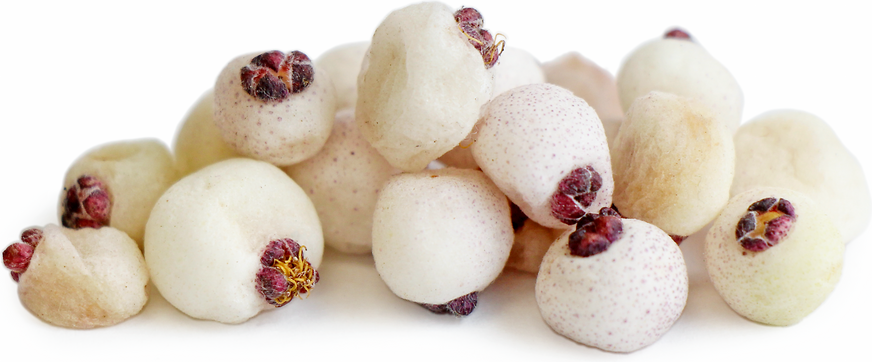


Midgen Berries
Estimated Inventory, bskt : 0
Description/Taste
Midgen berries are small, spherical fruits that grow on low shrubs. They are round and blueberry-like in shape, but can also appear wrinkled and deformed, resembling a raisin. These fruits measures 8 millimeters to 1 centimeter in diameter and have a hairy pinkish-brown calyx opposite their stem end. Midgen berries have white translucent skin that’s covered in blue-grey speckles, giving them a mauve-like tint. They sometimes develop faint brown spots when overripe or shriveled. Midgen berries have a dense, crunchy flesh and contain 3 to 9 pale brown, edible seeds. Their overall flavor and aroma is sweet yet mild, with notes of blueberry and hints of ginger, eucalyptus, and nutmeg.
Seasons/Availability
Midgen berries are available from late summer to early autumn.
Current Facts
Midgen berries are botanically known as Austromyrtus dulcis and are from the Myrtaceae family, which also includes guava, allspice, and eucalyptus. Commonly grown cultivars include Aurora, Bush Snacks, and Coppertop. They are referred to as Midyim berries, Silky Myrtle, the Australian blueberry, and Sand berries since they grow along the sandy coast. Midgen berries develop on shrubs and have an ornamental appeal because they bloom small white flowers with burgundy-bronze leaves that transition to green as they mature. These shrubs grow up to 2 meters high and bode well for landscape design, often used as borders and hedges in gardens. They attract wildlife like bees, birds, and butterflies and are frequently used in dessert and jam recipes.
Nutritional Value
Midgen berries provide vitamin C, encouraging immune and skin health, wound healing, collagen production, iron absorption, cognitive and blood vessel function, and protecting against bad cholesterol, high blood pressure, and UV rays. This fruit is a source of calcium, which may support strong bones and teeth, muscle and nerve function, and blood clotting. The iron in Midgen berries may benefit red blood cells and energy levels and fight against fatigue and anemia. As a source of dietary fiber, they help improve digestion, stabilize blood sugar levels, increase fullness, and prevent constipation. Midgen berries have long been valued in traditional Aboriginal medicine for their use in treating coughs, colds, and wounds.
Applications
Midgen berries are often consumed raw but may also be cooked, dried, or preserved. They are eaten fresh out of hand or tossed into salads, yogurt parfaits, and acai bowls. These berries bode well for jams and jelly making, where they are simmered with sugar and pectin and then thickened. They can serve as a substitute for blueberries in pies, tarts, crumbles, and muffins and can be used as a topping for cakes, pastries, flatbreads, granola, and couscous. Midgen berries pair well with chocolate, brown sugar, syrup, raspberries, blackberries, strawberries, mangoes, ice cream, cream cheese, mascarpone, goat cheese, mozzarella, salad greens, nuts, and roasted vegetables. They can be stored in the refrigerator for up to a week.
Ethnic/Cultural Info
The first written record of Midgen berries comes from an English explorer named James Backhouse. While traveling through Australia, he had to wade through a lagoon and cross steep hills before locating these fruits along the coast. He proclaimed them to be the most agreeable native food he had ever tasted in Australia. This island nation is known for growing many varieties of lesser-known tropical fruits like rambutan, mangosteen, black sapote, abiu, carambola, graviola, pitaya, and sapodilla. Many of these fruits flourish in Queensland, home to Moreton Bay, where Midgen berries were traditionally enjoyed by Aboriginal Australians.
Geography/History
Midgen berries are native to northern New South Wales and Southeast Queensland. Their natural habitat consists of woodlands, heathlands, and rainforests. Midgen berries prefer tropical and subtropical climates with full sun or partial shade. They are best located under overhanging tree branches to protect from frost. These berries have been foraged by Aborigines for hundreds of years. Midgen berries have never reached extensive commercial popularity because they are difficult to harvest and ship. They are grown in gardens from seed but may also be found in small markets across Australia.
Recipe Ideas
Recipes that include Midgen Berries. One
| Sustainable Gardening Australia |
|
Midyim Berry & Apple Pastry Slice |




